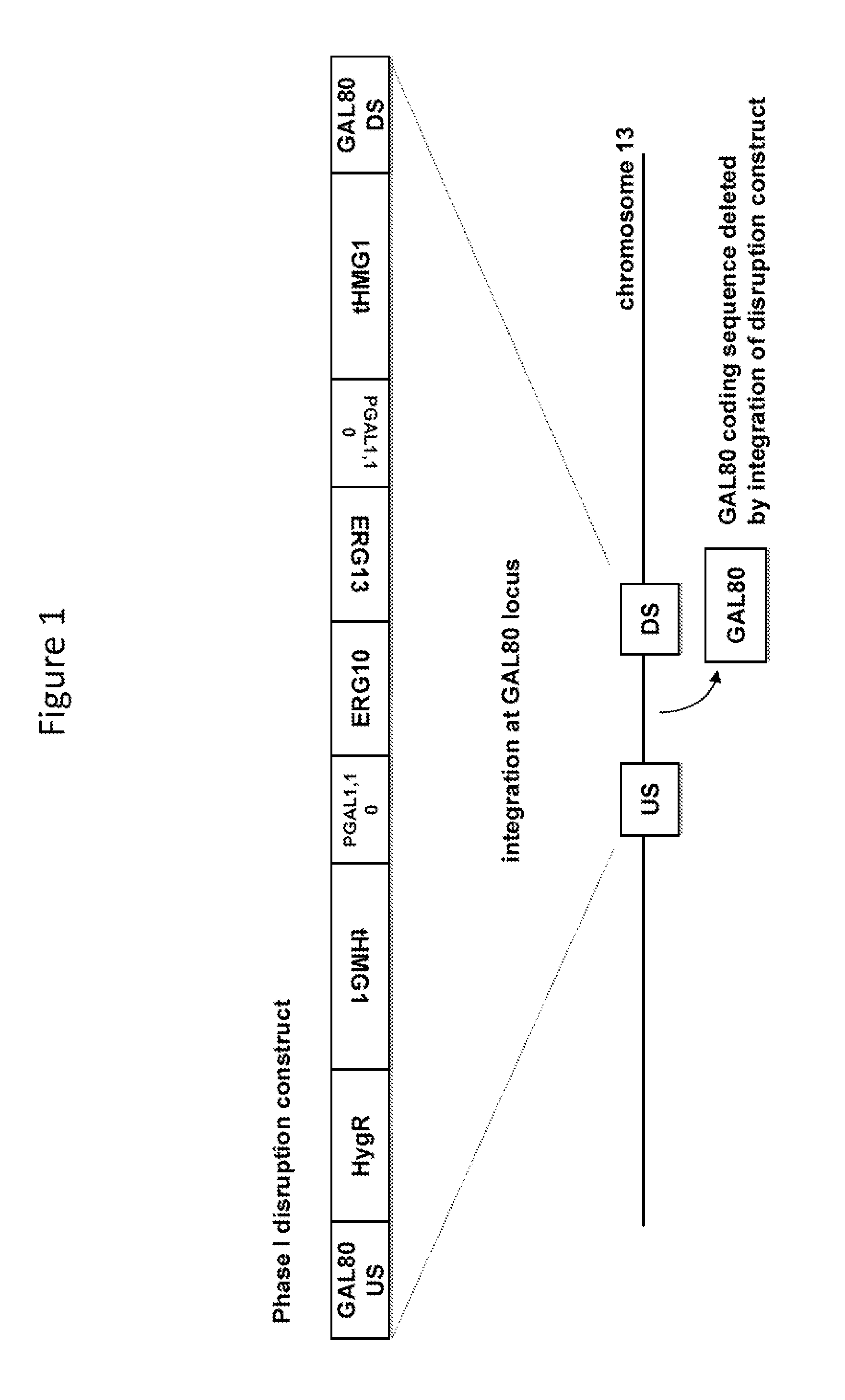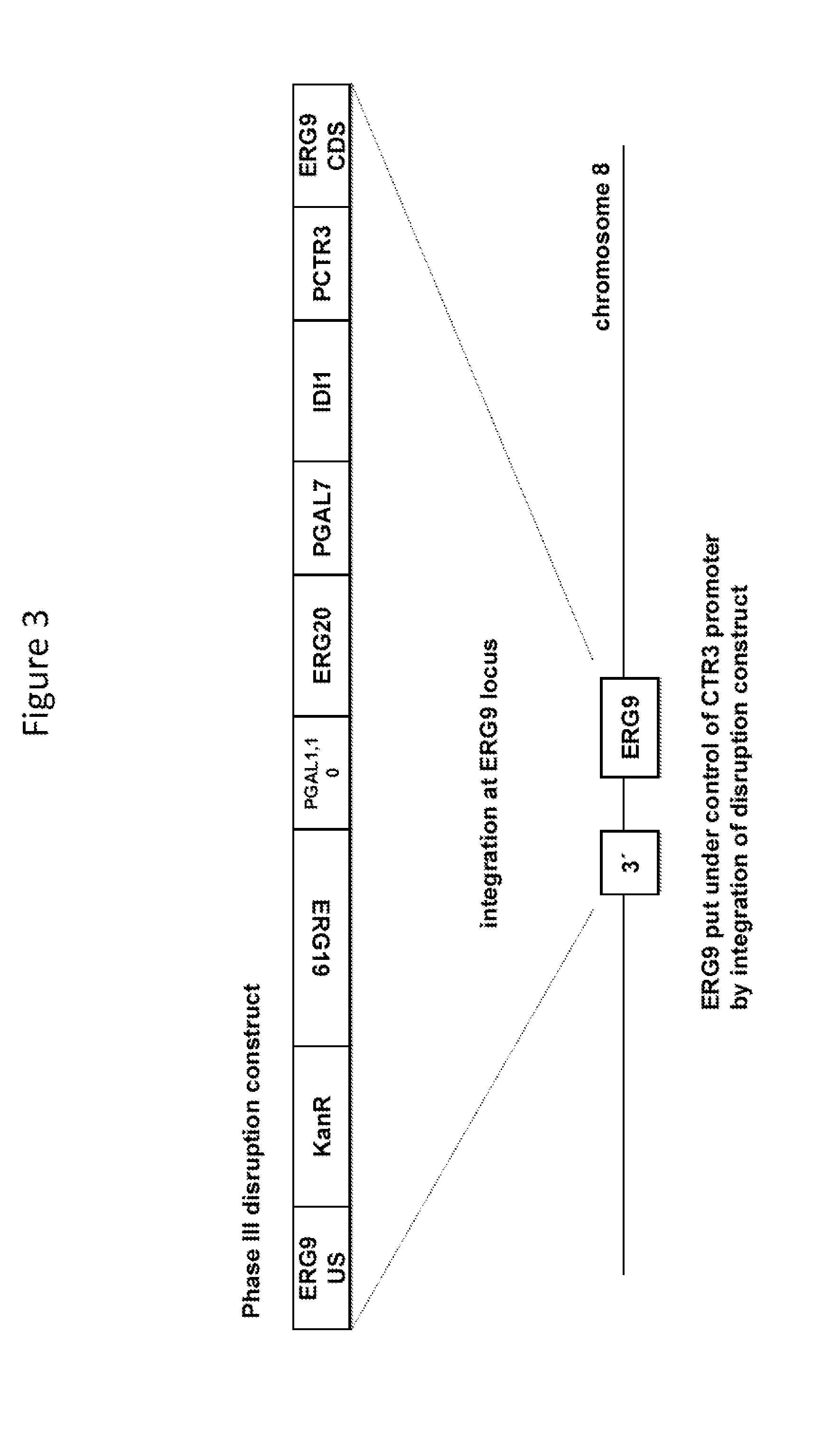Method for generating a genetically modified microbe
a technology microorganisms, applied in the field of genetically modified yeast generation, can solve the problems of environmental risk of use of genetically modified yeast in the industry, and achieve the effect of reducing the risk of being disseminated
- Summary
- Abstract
- Description
- Claims
- Application Information
AI Technical Summary
Benefits of technology
Problems solved by technology
Method used
Image
Examples
example 1
Generation of Genetically Modified Haploid Cells
[0099]This example describes an exemplary method for generating genetically modified haploid S. cerevisiae cells.
[0100]The Phase I disruption construct (FIG. 1; SEQ ID NO: 141) comprises as a disrupting sequence nucleotide sequences that encode a selectable marker (hygA, which confers resistance to hygromycin B); two enzymes of the S. cerevisiae MEV pathway (the truncated HMG1 coding sequence, which encodes a truncated HMG-CoA reductase, and the ERG13 coding sequence, which encodes HMG-CoA synthase), and another enzyme of S. cerevisiae (the ERG10 coding sequence, which encodes acetoacetyl-CoA thiolase), under control of galactose-inducible promoters (promoters of the S. cerevisiae genes GAL1 and GAL10); flanked by homologous sequences consisting of upstream and downstream nucleotide sequences of the S. cerevisiae GAL80 locus. Upon introduction into a S. cerevisiae host cell, the Phase I disruption construct can integrate by homologous ...
example 2
Generation of Genetically Modified Sporulation and Endogenous Mating Impaired Haploid Cells
[0117]This example describes an exemplary method for disrupting a sporulation gene and a pheromone response gene in a genetically modified haploid S. cerevisiae cell to yield a genetically modified haploid S. cerevisiae cell that is sporulation and endogenous mating impaired.
[0118]The STE5 disruption construct (FIG. 7; SEQ ID NO: 147) comprises as a disrupting sequence nucleotide sequences that encode a selectable marker (URA3, which confers the ability to grow on media lacking uracil); and an enzyme of the S. cerevisiae MEV pathway (the truncated HMG1 coding sequence, which encodes a truncated HMG-CoA reductase), under regulatory control of the promoter of the S. cerevisiae TDH3 gene; flanked by homologous sequences consisting of upstream and downstream nucleotide sequences of the S. cerevisiae STE5 locus. Upon introduction into a S. cerevisiae host cell, the STE5 disruption construct can int...
example 3
Generation of Genetically Modified Sporulation and Endogenous Mating Impaired Diploid Cells
[0122]This example describes an exemplary method for rendering diploid a genetically modified haploid S. cerevisisea cell that is sporulation and endogenous mating impaired.
[0123]Diploid host strain Y1979 was generated by self-mating of strain Y1915. To generate cells of opposite mating types and to transiently render strain Y1915 capable of mating, the strain was co-transformed with plasmid pAM1124 (SEQ ID NO: 149), which encodes the HO protein and the nourseothricin resistance marker; and plasmid pAM1758 (SEQ ID NO: 150), which encodes STE5 and the G418 resistance marker. Host cell transformants were selected on CSM containing G418 and nourseothricin. Positive transformants were replated for single colonies on a non-selective medium, and G418 sensitive, nourseothricin sensitive diploids were identified through screening using colony PCR.
PUM
| Property | Measurement | Unit |
|---|---|---|
| weight | aaaaa | aaaaa |
| volume | aaaaa | aaaaa |
| pH | aaaaa | aaaaa |
Abstract
Description
Claims
Application Information
 Login to View More
Login to View More - R&D
- Intellectual Property
- Life Sciences
- Materials
- Tech Scout
- Unparalleled Data Quality
- Higher Quality Content
- 60% Fewer Hallucinations
Browse by: Latest US Patents, China's latest patents, Technical Efficacy Thesaurus, Application Domain, Technology Topic, Popular Technical Reports.
© 2025 PatSnap. All rights reserved.Legal|Privacy policy|Modern Slavery Act Transparency Statement|Sitemap|About US| Contact US: help@patsnap.com



